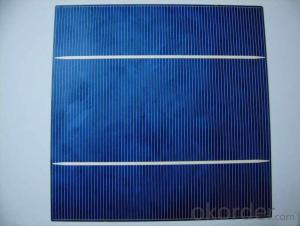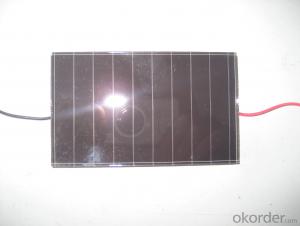Amorphous silicon dice specification 4
- Loading Port:
- China Main Port
- Payment Terms:
- TT OR LC
- Min Order Qty:
- -
- Supply Capability:
- -
OKorder Service Pledge
OKorder Financial Service
You Might Also Like
Pv modules at present, the mainstream products are still in silicon as the main raw materials, only in terms of silicon raw material consumption, production 1 mw of crystalline silicon solar cell, need 10 to 12 tons of high purity silicon, but if use the same silicon materials used to produce thin film amorphous silicon solar cell can produce more than 200 mw.
From the perspective of energy consumption, amorphous silicon solar battery only 1-1.5 years of energy recovery period, more embodies its contribution to energy saving in the manufacturing process.
Component occupies a high proportion of costs in a photovoltaic system, the component prices directly affect the system cost, and thus affect the cost of photovoltaic power generation. Calculated at the current price of components, the same money, buy amorphous silicon products, you can get more close to 30% of the power components.
2, more power
For the same power of solar cell array, amorphous silicon solar cell is about 10% more than monocrystalline silicon, polycrystalline silicon battery power. This has been the Uni - Solar System LLC, Energy Photovoltaic Corp., Japan's Kaneka Corp., the Netherlands Energy research institute, and other organizations and experts confirmed that the Photovoltaic industry.
In sunny, that is to say, under the high temperature, amorphous silicon solar cell components can show more excellent power performance.
3, better low light response
Due to the characteristics of amorphous silicon atoms are arranged disorderly, the electron transition no longer comply with the restriction of traditional \"selection rule\", as a result, its light absorption characteristics and there are big differences monocrystalline silicon material. Amorphous silicon and monocrystalline silicon material absorption curve as shown
, amorphous silicon absorption curve has obvious three sections (A, B, C). Area A corresponding electronic transition between localized states, such as the gap state near Fermi level and to the tail state transition, the absorption coefficient is small, about 1-10 cm - 1, for this is absorbing; B area absorption coefficient with the increase of the photon energy index rose, it corresponds to the electrons from the valence band edge extension state to the conduction band localized state transition, as well as the localized electrons from the valence band tail states guide for edge extension state transition, the region's energy range is usually only about half of the electron volts, but absorption coefficient across two or three orders of magnitude, usually up to 104 cm - 1; Area C corresponds to the electrons from the valence band to the conduction band internal internal transition, the absorption coefficient is bigger, often in more than 104 cm - 1. After two absorption area is crystalline silicon eigen absorption area.
Can be seen in the figure, the intersection of two curves about 1.8 ev. It is important to note that in the visible light range (1.7 to 3.0 ev), the absorption coefficient of amorphous silicon material is almost an order of magnitude larger than the single crystal silicon. That is to say, in the morning the first part of the sun is not too strong, the second half, and it's cloudy in the afternoon under the condition of low light intensity, long wave is greater, the amorphous silicon material still has a large absorption coefficient. Again considering the amorphous silicon band gap is larger, the reverse saturation current I0 is smaller. And as mentioned the amorphous silicon battery the characteristics I - V characteristic curve of the amorphous silicon solar cell both in theory and in practical use in low light intensity has good adaptation.
• I - V characteristics of amorphous silicon cells after more than a Vm with the voltage drop slowly
In order to be convenient, we draw the I - V characteristics of two kinds of batteries on the same picture. Crystalline silicon and amorphous silicon battery I - V characteristics of general shape as shown
we see from the picture, two kinds of cells in the curve changes after exceed the maximum output power point gap is bigger. Output current of crystalline silicon cells after exceed the maximum output power point will soon fall to zero, curve steep; Rather than crystalline silicon cells output current after a long distance to fall to zero, the curve is relatively flat. Two kinds of battery Vm equivalent to about 83% of its open circuit voltage and 83% respectively.
when light intensity gradually become hour, short circuit current and open circuit voltage of solar battery will be stronger. Short circuit current decreases faster, of course, open circuit voltage decrease more slowly.
do in battery solar cell array under the condition of load, when the sun battery array of effective output voltage less than the terminal voltage of battery, battery cannot be recharged. When the light intensity gradually become hour, crystal silicon battery charging does not meet the conditions, and amorphous silicon due to the larger voltage difference, do not charge until the light is very dark, effectively increase the use of sunlight time. So, amorphous silicon cells to produce more electricity than the crystalline silicon.
4, more excellent high temperature performance
High in the outdoor environment temperature, amorphous silicon solar cell performance change, depends on the temperature, spectrum, as well as other related factors. But what is certain is: amorphous silicon than monocrystalline silicon or polycrystalline silicon are less likely to be affected by temperature.
Amorphous silicon solar cells than monocrystalline silicon, polycrystalline silicon cells have relatively small temperature coefficient of amorphous silicon solar cell output power best Pm temperature coefficient is about 0.19%, and monocrystalline silicon, polycrystalline silicon cells best output power Pm temperature coefficient is about 0.5%, when the battery work at higher temperatures, the two batteries will be a drop in the Pm, but the decline is different. They can be calculated using the following formula.
- Q:How are solar silicon wafers protected from moisture during storage?
- Solar silicon wafers are typically protected from moisture during storage by encapsulating them in a protective packaging such as airtight bags or containers with desiccants. This helps to prevent any moisture from coming into contact with the wafers, which could potentially degrade their performance or cause damage.
- Q:I would like to ask the unit in the production of silicon production line workers do harm to the body? (is the production of monocrystalline silicon, polycrystalline silicon photovoltaic enterprises)
- Please also note: as long as it is in the production of factory work, there are more or less some occupation hazards, such as peripheral equipment operation noise, dust production, if the production site without the necessary protective equipment is also possible occupation disease.So my answer is only from the perspective of occupational protection.
- Q:How are solar silicon wafers packaged and shipped?
- Solar silicon wafers are typically packaged and shipped in a protective manner to ensure their safety during transportation. They are usually packed in anti-static foam trays or custom-designed plastic containers to prevent any damage from static electricity or physical impact. These trays or containers are then placed in larger boxes or crates, often with additional cushioning materials like foam or bubble wrap to further protect the wafers. The boxes are labeled with relevant shipping information and may be secured with tape or straps for added security. Finally, the packaged wafers are transported using appropriate shipping methods, such as air freight, trucking, or sea freight, depending on the distance and destination.
- Q:Can solar silicon wafers be used in water desalination plants?
- Yes, solar silicon wafers can be used in water desalination plants. They can be utilized as a component in solar panels to generate electricity, which can then be used to power the desalination process.
- Q:Can solar silicon wafers be used in solar-powered space vehicles?
- Yes, solar silicon wafers can be used in solar-powered space vehicles. Solar silicon wafers are commonly used in photovoltaic systems to convert sunlight into electricity. In space, where there is abundant sunlight, solar panels made with silicon wafers can efficiently capture and convert solar energy into electrical power to operate various systems and equipment onboard the space vehicles.
- Q:Can solar silicon wafers be used in portable solar devices?
- Yes, solar silicon wafers can be used in portable solar devices. These wafers are commonly used in the production of solar cells, which are the primary component of solar panels. By incorporating solar silicon wafers into portable solar devices, such as solar-powered chargers or lights, these devices can harness sunlight to generate electricity and provide portable renewable energy solutions.
- Q:How do solar silicon wafers perform in urban environments?
- Solar silicon wafers generally perform well in urban environments. However, their efficiency may be slightly affected by factors like shading from nearby buildings or pollution in the air. Despite these challenges, advancements in solar technology and installation techniques have made it possible to maximize solar energy generation in urban areas.
- Q:Can solar silicon wafers be used in solar-powered irrigation systems?
- Yes, solar silicon wafers can be used in solar-powered irrigation systems. These wafers are commonly used in solar panels to convert sunlight into electricity. In a solar-powered irrigation system, the solar silicon wafers would be used to generate the necessary power to run the irrigation system, making it an efficient and sustainable solution for agriculture.
- Q:How do solar silicon wafers contribute to reducing greenhouse gas emissions?
- Solar silicon wafers contribute to reducing greenhouse gas emissions by enabling the production of solar cells, which generate clean and renewable electricity. By harnessing sunlight to generate power, solar silicon wafers eliminate the need for fossil fuel-based energy sources, such as coal or natural gas power plants, which emit greenhouse gases like carbon dioxide and methane. Thus, the use of solar silicon wafers in solar cells helps mitigate climate change and reduce our overall carbon footprint.
- Q:How much energy is needed to produce a solar silicon wafer?
- The amount of energy required to produce a solar silicon wafer varies depending on various factors such as the manufacturing process, equipment efficiency, and location. However, on average, it is estimated that producing a solar silicon wafer requires around 120-200 kilowatt-hours (kWh) of energy per kilogram of silicon.
1. Manufacturer Overview |
|
|---|---|
| Location | |
| Year Established | |
| Annual Output Value | |
| Main Markets | |
| Company Certifications | |
2. Manufacturer Certificates |
|
|---|---|
| a) Certification Name | |
| Range | |
| Reference | |
| Validity Period | |
3. Manufacturer Capability |
|
|---|---|
| a)Trade Capacity | |
| Nearest Port | |
| Export Percentage | |
| No.of Employees in Trade Department | |
| Language Spoken: | |
| b)Factory Information | |
| Factory Size: | |
| No. of Production Lines | |
| Contract Manufacturing | |
| Product Price Range | |
Send your message to us
Amorphous silicon dice specification 4
- Loading Port:
- China Main Port
- Payment Terms:
- TT OR LC
- Min Order Qty:
- -
- Supply Capability:
- -
OKorder Service Pledge
OKorder Financial Service
Similar products
New products
Hot products
Hot Searches
Related keywords

























